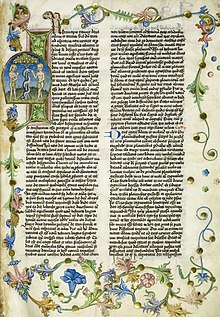
Back يوسيفوس عن يسوع Arabic Testimonium Flavianum Breton Testimoni flavià Catalan Testimonium flavianum Czech Testimonium Flavianum Danish Testimonium Flavianum German Testimonium Flavianum Esperanto Testimonio flaviano Spanish Testimonium Flavianum Estonian Testimonium flavianum French

| Part of a series on |
 |
The extant manuscripts of the book Antiquities of the Jews, written by the first-century Jewish historian Flavius Josephus around AD 93–94, contain two references to Jesus of Nazareth and one reference to John the Baptist.[1]
The first and most extensive reference to Jesus in the Antiquities, found in Book 18, states that Jesus was the Messiah and a wise teacher who was crucified by Pontius Pilate. It is commonly called the Testimonium Flavianum.[2] Nearly all modern scholars reject the authenticity of this passage in its present form, though most nevertheless hold that it contains an authentic nucleus referencing the life and execution of Jesus by Pilate, which was then subjected to Christian interpolation and alteration.[3][4] However, the exact nature and extent of the original statement, if it even existed, remains unclear.[5][6]
Modern scholarship has largely acknowledged the authenticity of the second reference to Jesus in the Antiquities, found in Book 20, Chapter 9, which mentions "the brother of Jesus, who was called Christ, whose name was James."[7] This reference is considered to be more authentic than the Testimonium.[8][9][10]
Almost all modern scholars consider the reference in Book 18, Chapter 5 of the Antiquities to the imprisonment and death of John the Baptist also to be authentic and not a Christian interpolation.[11] A number of differences exist between the statements by Josephus regarding the death of John the Baptist and the New Testament accounts.[12] Scholars generally view these variations as indications that the Josephus passages are not interpolations, since a Christian interpolator would likely have made them correspond to the New Testament accounts, not differ from them.[13] Scholars have provided explanations for their inclusion in Josephus' later works.[14]
- ^ Feldman & Hata 1987, pp. 54–57; Flavius Josephus & Maier 1995, p. 12.
- ^ Feldman & Hata 1987, pp. 54–57; Maier 2007, pp. 336–337; Schreckenberg & Schubert 1992a, pp. 38–41.
- ^ Maier 2007, pp. 336–337; Schreckenberg & Schubert 1992a, pp. 38–41; Dunn 2003, p. 141; Kostenberger, Kellum & Quarles 2009, pp. 104–108; Evans 2001, p. 316; Wansbrough 2004, p. 185; Van Voorst 2003, pp. 509–511.
- ^ Ehrman, Bart D. (24 February 2019). "Do Any Ancient Jewish Sources Mention Jesus?". The Bart Ehrman Blog.
If this is something Josephus wrote, as most scholars continue to think, then it indicates that Jesus was a wise man and a teacher who performed startling deeds and as a consequence found a following among both Jews and Greeks; it states that he was accused by Jewish leaders before Pilate, who condemned him to be crucified; and it points out that his followers remained devoted to him even afterward (Ant. 18.3.3)
- ^ Cohen, Shaye J. D. (2011). "Josephus". In Levine, Amy-Jill; Brettler, Marc Zvi (eds.). The Jewish Annotated New Testament. p. 576. ISBN 978-0-19-529770-6.
Most modern scholars believe that Josephus could not have written this text as we have it... Scholars disagree about exactly how to reconstruct the original of the passage.
- ^ Wilhelm Schneemelcher, Robert McLachlan Wilson, New Testament Apocrypha: Gospels and Related Writings, page 490 (James Clarke & Co. Ltd, 2003). ISBN 0-664-22721-X
- ^ Louis Feldman (ISBN 90-04-08554-8 pages 55–57) states that the authenticity of the Josephus passage on James has been "almost universally acknowledged".
- ^ Van Voorst 2000, p. 83; Feldman & Hata 1987, pp. 54–57; Flavius Josephus & Maier 1995, pp. 284–285; Bauckham 1999, pp. 199–203; Painter 2005, pp. 134–141.
- ^ Sample quotes from previous references: Van Voorst (ISBN 0-8028-4368-9 page 83) states that the overwhelming majority of scholars consider both the reference to "the brother of Jesus called Christ" and the entire passage that includes it as authentic." Bauckham (ISBN 90-04-11550-1 pages 199–203) states: "the vast majority have considered it to be authentic". Meir (ISBN 978-0-8254-3260-6 pages 108–109) agrees with Feldman that few have questioned the authenticity of the James passage. Setzer (ISBN 0-8006-2680-X pages 108–109) also states that few have questioned its authenticity.
- ^ Johnson, Luke Timothy (2005). The letter of James: a new translation with introduction and commentary. New Haven; London: Yale University Press. p. 98.
- ^ Evans 2006, pp. 55–58; Bromiley 1982, pp. 694–695; White 2010, p. 48.
- ^ Evans 2006, pp. 55–58; Painter 2005, pp. 143–145.
- ^ Evans 2006, pp. 55–58; Eddy & Boyd 2007, p. 130; Painter 2005, pp. 143–145.
- ^ Feldman 1984, p. 826.
© MMXXIII Rich X Search. We shall prevail. All rights reserved. Rich X Search